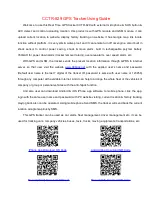
5 - PROCEDURES
83
the screen. If you have passed the MAP, the 500W-
series unit proceeds to the transition waypoint without
a restart confirmation.
Basic Approach Operations
The 500W-series provides vertical and non-preci-
sion approach guidance using its built-in GPS receiver.
The moving map pages can also be used as a supple-
mental aid to situational awareness for ILS, VOR, and
NDB approaches (and non-precision localizer-based
approaches), but the localizer and glideslope receivers
MUST be used for primary approach course guidance.
The 500W-series also provides GPS precision capa-
bility, known as LPV and LNAV/VNAV approaches.
LNAV+V approaches provide vertical guidance but are
not precision approaches.
Approaches designed specifically for GPS are often
very simple and don’t require overflying a VOR or
NDB. Currently, many non-precision approaches have
“GPS overlays” to let you fly an existing procedure
(VOR, VOR/DME, NDB, RNAV, etc.) more accurately
using GPS. To date, there are over 2,400 GPS-only
approaches and over 2,900 GPS overlay approaches
worldwide.
Many overlay approaches are more complex (in
comparison to GPS-only approaches). The 500W-
series unit displays and guides you through each leg
of the approach — automatically sequencing through
each of these legs, up to the missed approach point
(MAP). Approaches may be flown “as published” with
the full transition — using any published feeder route
or initial approach fix (IAF) — or may be flown with a
vectors-to-final transition.
Flight mode annunciations are provided in the
lower left corner of the display indicating the current
mode of flight.
Annunciation
Description
LPV
Follow lateral and vertical guidance to LPV
minimums. A yellow background indicates
the current VPL and/or HPL values are not
adequate for the approach and is an early
indication that downgrading will occur if
conditions do not improve.
L/VNAV
GPS approach identified in the database as
LNAV/VNAV. Fly to LNAV/VNAV minimums.
LNAV+V
Non-precision GPS approach with advanced
vertical guidance. Note that some LNAV/VNAV
approaches are not yet marked in the data-
base as such and will show up as LNAV+V. If
the chart shows the approach as LNAV/VNAV,
it can be flown to LNAV/VNAV minimums.
LNAV
Non-precision GPS approach or non-GPS
approach, such as ILS or Localizer.
MAPR
Missed Approach, indicates the system is
providing missed approach integrity and CDI
full-scale deflection ±0.3 NM. This also shows
that the pilot has initiated a Missed Approach
by pressing the
OBS
key after crossing the
MAP.
ENR
En route, CDI full-scale deflection is 2.0 NM
or current CDI scale selection, whichever is
smaller.
TERM
Terminal, CDI full-scale deflection is 1.0 NM
or current CDI scale selection, whichever is
smaller.
DPRT
Departure, indicates the system is using non-
precision approach integrity. HAL = 0.3 and
CDI full-scale deflection is 0.3 NM.
OCN
Oceanic, CDI full-scale deflection is 2.0 NM.
LOW ALT
(lower window)
For LNAV+V, LNAV/VNAV, or LPV approaches,
the LOW ALT annunciation indicates the
aircraft’s estimated height is lower than the
Final Approach Waypoint height by more than
the current VPL plus 50 meters.
Basic Approach Operations
Summary of Contents for GNS 530W
Page 1: ...500W Series Pilot s Guide Reference...
Page 10: ...INTRODUCTION viii Blank Page...
Page 90: ...4 FLIGHT PLANS 80 Blank Page...
Page 152: ...6 WPT PAGES 142 Blank Page...
Page 196: ...9 AUX PAGES 186 Setup 2 Page Blank Page...
Page 208: ...12 MESSAGES ABBREVIATIONS NAV TERMS 198 Blank Page...
Page 228: ...APPENDIX D Index 218 Blank Page...
Page 229: ......















































